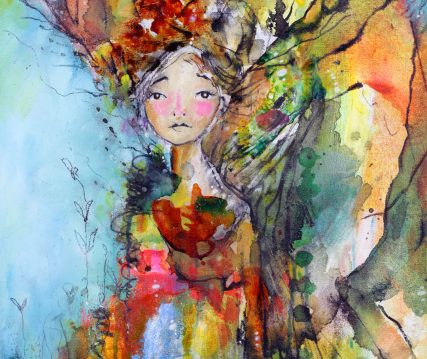No products in the cart.
Return To ShopLately, I’ve been experimenting with acrylic paints and water-soluble pencil, along with acrylic paints and inks. It’s fun to add acrylic ink and then color with pastels, picking up some of the ink, creating new color combinations, and lots of beautiful mistakes (especially when I dump water on top).
Once that dries, I begin to pencil in my face and body. I love to keep scribbling to see what happens. The first time I tried this technique, I didn’t love the colors, but I loved what happened with the layers. So I tried again, intentionally, with my favorite colors.
Now, my latest collection is coming to life. I’ll share more with you soon.
If you’ve been wanting to experiment with inks in your mixed media layers, here are a few tips and techniques:
ACRYLIC INKS: Acrylic inks are water-based and come in a small bottle with a dropper. They’re similar to acrylic paints or fluid acrylic paints, which have a thicker consistency than acrylic inks and are thinner than acrylic paints – you can pour out fluid acrylics as well. All of these create brilliant color, with acrylic inks being most transparent, without looking watered down. I like to add water to all of these, but the acrylic inks and fluid acrylics are also fun to just let bleed together to create luscious layers full of drips and color, so you can still see the layers underneath once they’ve dried. Acrylic inks also come in pearlescent colors which are very pretty.
INDIA INK: India ink is another option which is much more saturated in color and, to me, doesn’t have the same luminosity and pop as acrylic inks. But it’s especially great for lines and marks. I love to use a waterproof black india or calligraphyink for outlines in my paintings.
ALCOHOL INKS: Alcohol inks are alcohol-based and create a very different effect that, to me, is much less controllable with the layers I like to add. I stopped using many alcohol inks in my work because I’d cover them up with acrylics and not see them, but then when I added my top coat (Mod Podge at that time), the alcohol ink showed through – right on a face which I did not want. But I’ve still used them to create backgrounds and have just been really conscious to put them at the bottom of a painting where I won’t have as much detail or just in a corner for effect.
Whenever I layer inks in my paintings with other water-based supplies, these are the guidelines I follow:
- Layering Magic: Build layers intentionally. Each layer adds depth and complexity to your painting. Don’t be afraid to cover and uncover elements until you achieve a rich color and contrast.
- Color Fusion: Explore the transparency of different colors in your layers. Let acrylic inks bleed into each other, creating a mesmerizing effect like stained glass. This technique adds vibrancy and visual interest.
- Reflect On What Worked: Take time to reflect on each piece. What worked well? What can be improved? Repeat the elements and color combinations you loved in your next painting.
So often my new favorite technique comes from a beautiful mistake. Sometimes it’s hard to repeat. But in the trying, again and again, new beauty emerges.
The invitation is to experiment with different techniques, discover new mediums, and play. Take out your sketchbook and have fun. I’ve put together a New Free Painting Class to help you get started here.
I hope it brings you a little calm and helps you to stay motivated and inspired!
Happy painting!
Love, Juliette
Comments are closed




HELLO
I'M JULIETTE
A painter, writer, and creator of The School Of Happy Painting, online courses to help you loosen up, let go, and develop your own unique style.
Join me for a Free Workshop!
Want to know how I create my paintings? Join this free workshop to learn the fundamental principles I use to paint with style and whimsy, from covering up the white space to final artwork. Follow along to paint your own character in 30 minutes.





